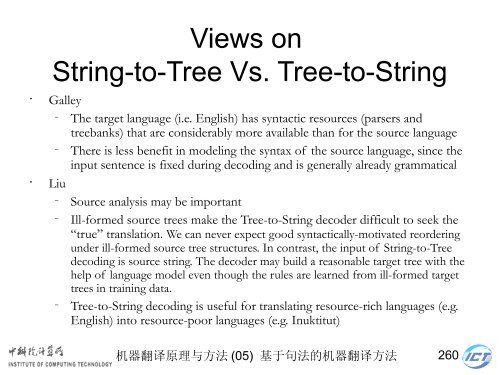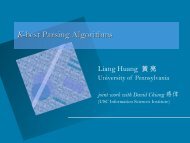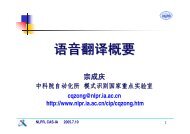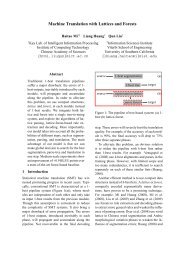- Page 1 and 2:
机 器 翻 译 原 理 与 方 法
- Page 3 and 4:
概 述 • 基 于 短 语 的 统
- Page 5 and 6:
统 计 机 器 翻 译 方 法 的
- Page 7 and 8:
基 于 句 法 的 统 计 机 器
- Page 9 and 10:
基 于 句 法 的 统 计 机 器
- Page 11 and 12:
语 言 学 上 基 于 句 法 的
- Page 13 and 14:
同 步 语 法 (1) • 定 义 :
- Page 15 and 16:
同 步 语 法 (3) • 同 步 语
- Page 17 and 18:
反 向 转 录 语 法 • Inversi
- Page 19 and 20:
反 向 转 录 语 法 机 器 翻
- Page 21 and 22:
基 于 反 向 转 录 语 法 的
- Page 23 and 24:
括 号 转 录 语 法 • Bracket
- Page 25 and 26:
这 里 给 出 了 四 个 词 的
- Page 27 and 28:
真 实 自 然 语 言 的 翻 译
- Page 29 and 30:
基 于 最 大 熵 括 号 转 录
- Page 31 and 32:
ME-BTG : 基 本 思 想 • 在 BT
- Page 33 and 34:
ME-BTG 训 练 单 词 对 齐 的
- Page 35 and 36:
重 排 序 特 征 • 单 目 特
- Page 37 and 38:
基 于 ME-BTG 的 统 计 机 器
- Page 39 and 40:
基 于 ME-BTG 模 型 的 翻 译
- Page 41 and 42:
基 于 ME-BTG 模 型 的 翻 译
- Page 43 and 44:
基 于 ME-BTG 模 型 的 翻 译
- Page 45 and 46:
内 容 提 要 • 概 述 • 同
- Page 47 and 48:
同 步 上 下 文 无 关 语 法
- Page 49 and 50:
同 步 上 下 文 无 关 语 法
- Page 51 and 52:
同 步 上 下 文 无 关 语 法
- Page 53 and 54:
同 步 上 下 文 无 关 语 法
- Page 55 and 56:
同 步 上 下 文 关 语 法 的
- Page 57 and 58:
同 步 上 下 文 关 语 法 的
- Page 59 and 60:
同 步 上 下 文 关 语 法 的
- Page 61 and 62:
算 法 复 杂 度 • 机 器 翻
- Page 63 and 64:
层 次 短 语 模 型 (1) • 层
- Page 65 and 66:
观 察 : 短 语 的 层 次 性
- Page 67 and 68:
用 层 次 短 语 进 行 翻 译
- Page 69 and 70:
用 同 步 语 法 表 示 层 次
- Page 71 and 72:
层 次 短 语 的 抽 取 机 器
- Page 73 and 74:
非 终 结 符 标 记 • 到 目
- Page 75 and 76:
粘 合 规 则 ( Glue Rules ) •
- Page 77 and 78:
模 型 • 直 接 利 用 同 步
- Page 79 and 80:
模 型 特 征 机 器 翻 译 原
- Page 81 and 82:
小 结 • 形 式 上 基 于 句
- Page 83 and 84:
树 到 串 翻 译 模 型 • 树
- Page 85 and 86:
基 于 树 到 串 对 齐 模 板
- Page 87 and 88:
树 到 串 对 齐 模 板 NP LCP
- Page 89 and 90:
Tree-based Translation ● Recursiv
- Page 91 and 92:
Tree-based Translation ● Recursiv
- Page 93 and 94:
Tree-based Translation ● Recursiv
- Page 95 and 96:
Tree-based Translation ● Recursiv
- Page 97 and 98:
模 型 特 征 机 器 翻 译 原
- Page 99 and 100:
Tree-to-String Rule Extraction ●
- Page 101 and 102:
Tree-to-String Rule Extraction ●
- Page 103 and 104:
Tree-to-String Rule Extraction ●
- Page 105 and 106:
解 码 • 自 底 向 上 • 柱
- Page 107 and 108:
Tree-based Button-up Decoding
- Page 109 and 110:
Tree-based Button-up Decoding
- Page 111 and 112:
Tree-based Button-up Decoding
- Page 113 and 114:
Tree-based Button-up Decoding ● B
- Page 115 and 116:
剪 枝 策 略 • 模 板 表 剪
- Page 117 and 118:
实 验 • Baseline : Pharaoh (Koe
- Page 119 and 120:
实 验 环 境 • 评 测 工 具
- Page 121 and 122:
与 短 语 的 兼 容 性 • TAT
- Page 123 and 124:
例 子 TAT table NP NR NN NP 布
- Page 125 and 126:
例 子 NP NR NN 布 什 总 统 NP
- Page 127 and 128:
利 用 非 句 法 双 语 短 语
- Page 129 and 130:
解 决 方 法 • 搜 索 结 束
- Page 131 and 132:
例 子 IP NP-B VP PU NN NN NN ADVP
- Page 133 and 134:
加 大 数 据 规 模 • Bilingu
- Page 135 and 136:
小 结 • 基 于 树 到 串 对
- Page 137 and 138:
Parsing Mistake Propagation
- Page 139 and 140:
1-best ➜ n-best trees?
- Page 141 and 142:
Patten Matching on Forest
- Page 143 and 144:
Translation Forest
- Page 145 and 146:
Translation Forest
- Page 147 and 148:
N-best Trees vs. Forest
- Page 149 and 150:
Forest-based Rule Extraction ● Co
- Page 151 and 152:
Forest-based Rule Extraction ● Ex
- Page 153 and 154:
Forest-based Rule Extraction ● Ex
- Page 155 and 156:
Forest-based Rule Extraction ● Ex
- Page 157 and 158:
Fractional Count
- Page 159 and 160:
Results on forest training and deco
- Page 161 and 162:
基 于 串 的 方 法 Joint Parsi
- Page 163 and 164:
Joint Parsing and Translation
- Page 165 and 166:
Joint Parsing and Translation
- Page 167 and 168:
Joint Parsing and Translation
- Page 169 and 170:
Joint Parsing and Translation
- Page 171 and 172:
Joint Parsing and Translation
- Page 173 and 174:
Joint Parsing and Translation
- Page 175 and 176:
Joint Parsing and Translation
- Page 177 and 178:
Search Space Comparison String-base
- Page 179 and 180:
内 容 提 要 • 概 述 • 同
- Page 181 and 182:
ISI 的 工 作 • Ulrich Germann,
- Page 183 and 184:
同 步 生 成 树 、 串 和 对
- Page 185 and 186:
同 步 生 成 树 、 串 和 对
- Page 187 and 188:
同 步 生 成 树 、 串 和 对
- Page 189 and 190:
规 则 与 推 导 机 器 翻 译
- Page 191 and 192:
句 法 翻 译 概 率 表 机 器
- Page 193 and 194:
与 短 语 模 型 的 兼 容 性
- Page 195 and 196:
构 造 兼 容 规 则 (1) *NPB*_N
- Page 197 and 198:
构 造 兼 容 规 则 (3) • 兼
- Page 199 and 200:
训 练 • 规 则 抽 取 - Input
- Page 201 and 202:
将 树 到 串 对 齐 表 示 为
- Page 203 and 204:
一 些 概 念 定 义 • 一 个
- Page 205 and 206:
抽 取 规 则 算 法 • Step 1:
- Page 207 and 208:
抽 取 规 则 2 机 器 翻 译
- Page 209 and 210: 抽 取 规 则 4 机 器 翻 译
- Page 211 and 212: 抽 取 规 则 6 机 器 翻 译
- Page 213 and 214: 抽 取 规 则 8 机 器 翻 译
- Page 215 and 216: 抽 取 规 则 10 机 器 翻 译
- Page 217 and 218: 抽 取 规 则 12 机 器 翻 译
- Page 219 and 220: 未 对 齐 词 导 致 的 问 题
- Page 221 and 222: 源 语 言 未 对 齐 词 的 多
- Page 223 and 224: 新 的 规 则 抽 取 算 法 •
- Page 225 and 226: Marcu 的 规 则 抽 取 算 法
- Page 227 and 228: Marcu 的 规 则 抽 取 算 法
- Page 229 and 230: 估 计 规 则 概 率 按 规 则
- Page 231 and 232: EM 训 练 算 法 可 以 采 用
- Page 233 and 234: 解 码 • 采 用 自 底 向 上
- Page 235 and 236: Example NNS gunmen 枪 手 被 警
- Page 237 and 238: Example NP DT The NNS gunmen by IN
- Page 239 and 240: Example NP NP DT NNS IN DT NN the g
- Page 241 and 242: Example NP NP DT NNS IN DT NN VBN .
- Page 243 and 244: Example VP-C PP NP NP DT NNS VBN IN
- Page 245 and 246: Example S VP VP-C PP NP NP DT NNS V
- Page 247 and 248: 规 则 的 二 叉 化 ( Binarizat
- Page 249 and 250: Galley 的 实 验 : 不 同 规
- Page 251 and 252: Marcu 的 实 验 : SPMT Models •
- Page 253 and 254: Marcu 采 用 的 特 征 • proot
- Page 255 and 256: 实 验 结 果 : Marcu Vs. Och 机
- Page 257 and 258: Analysis • Galley - Good results
- Page 259: 总 结 • 同 步 语 法 • 形
- Page 263: 讨 论 机 器 翻 译 原 理 与









